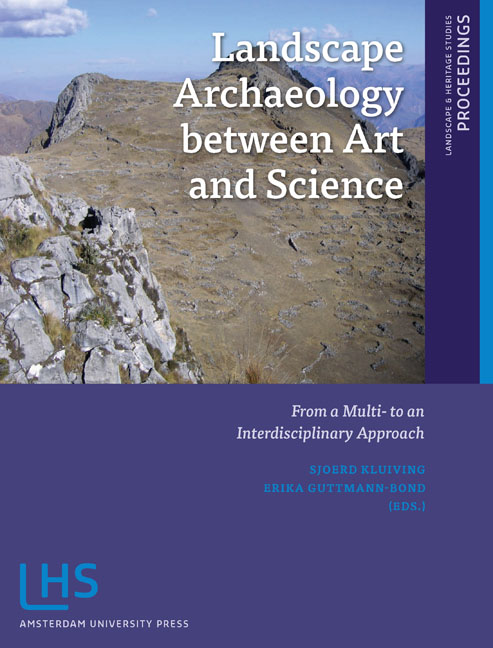Book contents
- Frontmatter
- Contents
- Preface
- Introduction: LAC2010: First International Landscape Archaeology Conference
- THEME 1 HOW DID LANDSCAPE CHANGE?
- THEME II IMPROVING TEMPORAL, CHRONOLOGICAL AND TRANSFORMATIONAL FRAMEWORKS
- THEME III LINKING LANDSCAPES OF LOWLANDS TO MOUNTAINOUS AREAS
- THEME IV APPLYING CONCEPTS OF SCALE
- THEME V NEW DIRECTIONS IN DIGITAL PROSPECTION AND MODELLING TECHNIQUES
- THEME VI HOW WILL LANDSCAPE ARCHAEOLOGY DEVELOP IN THE FUTURE?
- Miscellaneous Endmatter
5.2 - Using Google Earth and GIS to Survey in the Peruvian Andes
Published online by Cambridge University Press: 21 January 2021
- Frontmatter
- Contents
- Preface
- Introduction: LAC2010: First International Landscape Archaeology Conference
- THEME 1 HOW DID LANDSCAPE CHANGE?
- THEME II IMPROVING TEMPORAL, CHRONOLOGICAL AND TRANSFORMATIONAL FRAMEWORKS
- THEME III LINKING LANDSCAPES OF LOWLANDS TO MOUNTAINOUS AREAS
- THEME IV APPLYING CONCEPTS OF SCALE
- THEME V NEW DIRECTIONS IN DIGITAL PROSPECTION AND MODELLING TECHNIQUES
- THEME VI HOW WILL LANDSCAPE ARCHAEOLOGY DEVELOP IN THE FUTURE?
- Miscellaneous Endmatter
Summary
ABSTRACT
In the Central Cordillera of the Andes in Peru, the Ayacucho region offers a landscape of mountains and deep, warm valleys, whose vast ecological diversity has encouraged human settlement from the Archaic period, 10,000 years ago, up to the present day. The Choquek’iraw-Chanca project, initiated in 2007, aims at understanding the process of occupation in one part of this region, the ‘La Mar’ province (so-called Oreja de Perro, ‘dog's ear’), which is located between 1,000 and 4,500m altitude, in the north-east of Ayacucho (the regional capital).
Two survey campaigns were carried out in this area. These indicated a significant regional occupation that began soon after the Formative Period (± 500 BC) and continued through the Inca era (1532 AD), with a stronger presence of sites from the Late Intermediate period (1000 to 1400 AD), probably belonging to the Chanka. Today, there are still a few hamlets of people speaking the Quechua dialect and their rural lifestyle seems to be similar to that of pre-Columbian times.
Preliminary work on high definition satellite images from Google Earth enabled us to identify a few archaeological sites (villages and ceremonial centres). By surveying on foot, we discovered other sites that were not visible on Google Earth (burials in rock shelters, agriculture terraces and ancient roads). Each site has been properly recorded and referenced by GPS points (UTM WGS 84). This helps us integrate all the information recorded on the ground into a computer database and a Geographic Information System (GIS). The distribution of archaeological sites – most of which are Chanka villages – can then be shown on different base maps. The GIS also provides the opportunity to make thematic maps carry out spatial analysis via digital terrain model (DTM), e.g. slopes, site inter-visibility and visibility between sites and their environments, which allowed us to understand the different patterns of landscape occupation.
KEYWORDS
prospection, Google Earth, GIS, spatial analysis, Chanka, settlement
In the heart of the central Cordillera of the Andes in Peru, the region of Ayacucho displays a landscape of mountains and enclosed hot valleys with a great ecological diversity, which have been favourable to human settlement since the Archaic period 10,000 years ago (Mac Neish et al. 1983).
- Type
- Chapter
- Information
- Landscape Archaeology between Art and ScienceFrom a Multi- to an Interdisciplinary Approach, pp. 321 - 338Publisher: Amsterdam University PressPrint publication year: 2012



